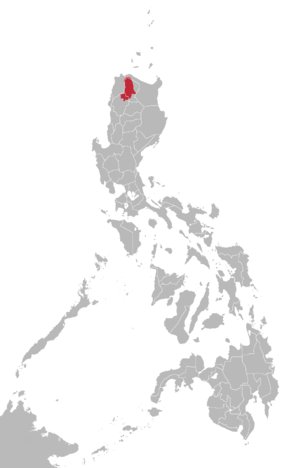Isnag language
| Isnag | |
|---|---|
| Isneg | |
| Native to | Philippines |
| Region | most parts of Apayao province, northern parts of Abra, Luzon |
Native speakers | 30,000–40,000 (1994)[1] |
| Language codes | |
| ISO 639-3 |
Either: isd – Isnag tiu – Adasen Itneg |
| Glottolog |
isna1241 (Isnag)[2]adas1235 (Adasen)[3] |
| Linguasphere |
31-CCA-a incl. inner units 31-CCA-aa...-ae |
|
Area where Isnag (including Adasen Isneg) is spoken according to Ethnologue | |
Isnag (also called Isneg) is a language spoken by around 40,000 Isnag people of Apayao Province in the Cordillera Administrative Region in the northern Philippines. Around 85% of Isnag are capable of reading the Isnag language. Many Isnag speakers also use Ilokano.
Sounds
Ibanag is also one of the Philippine languages which is excluded from [ɾ]-[d] allophone.
Language sample
- Isnag: Piyán tada din ya isaisa kadàtada wawwági, ta ya aminya ay gayát ke Dios. --1 Juan 4:7
- Isnag: Ay day-dayáwan tada nge Dios, nga Dios se Ama naya Apu tada nga Jesu-Cristo. --1 Pedro 1:3
- Approximate English Translation: Praise God, the God and Father of the Lord Jesus Christ. --1 Peter 1:3
Historical sound changes
The Proto-Malayo-Polynesian schwa ə has merged to /a/ such as *qatəp > atap (roof) similar to Kapampangan, atip in Tagalog and atup in Visayan.[4]
References
- ↑ Isnag at Ethnologue (18th ed., 2015)
Adasen Itneg at Ethnologue (18th ed., 2015) - ↑ Nordhoff, Sebastian; Hammarström, Harald; Forkel, Robert; Haspelmath, Martin, eds. (2013). "Isnag". Glottolog. Leipzig: Max Planck Institute for Evolutionary Anthropology.
- ↑ Nordhoff, Sebastian; Hammarström, Harald; Forkel, Robert; Haspelmath, Martin, eds. (2013). "Adasen". Glottolog. Leipzig: Max Planck Institute for Evolutionary Anthropology.
- ↑ http://language.psy.auckland.ac.nz/austronesian/word.php?v=62
